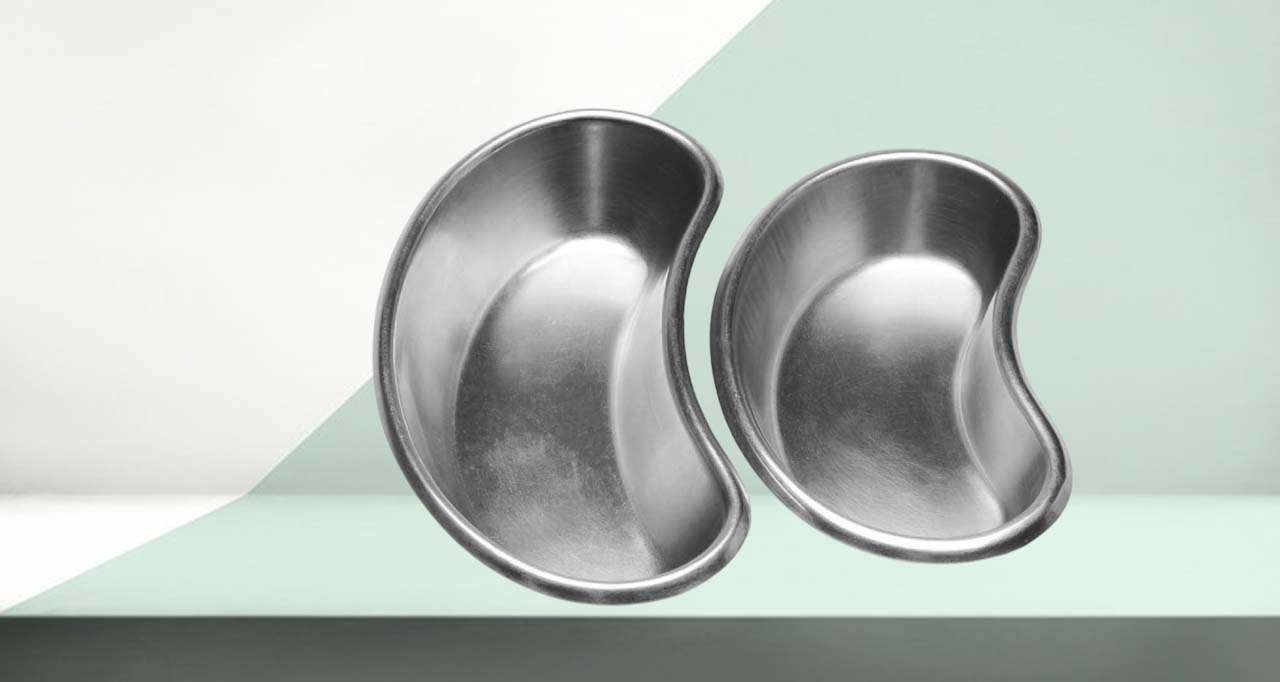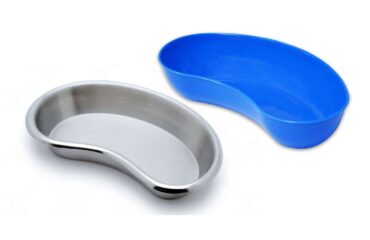A surgical kidney tray, also called an emesis basin, is a shallow, kidney-shaped, stainless steel or plastic dish commonly used in medical and surgical settings. Its shape allows it to fit closely against a patient’s body, especially under the chin or around the torso, to catch fluids or hold medical instruments.

Types of Surgical Kidney Trays
Kidney trays come in various materials and sizes depending on the specific surgical or clinical need:
Based on Material
Stainless Steel Kidney Trays are shallow, kidney-shaped containers used in medical settings for holding surgical instruments, dressings, or bodily fluids. Made from durable, rust-resistant stainless steel, they are easy to sterilize and commonly used in hospitals, clinics, and laboratories.
Stainless Steel Kidney Trays
- Most common in hospitals and surgical suites.
- Durable, autoclavable, and reusable.
- Resistant to corrosion and chemical stains.
Plastic Kidney Trays
Plastic kidney trays are shallow, kidney-shaped containers made from durable plastic. They are commonly used in medical and surgical settings to collect waste, hold instruments, or receive soiled dressings. Lightweight, easy to clean, and disposable or reusable, they help maintain hygiene and convenience during patient care.
- Lightweight and often disposable or semi-reusable.
- Made from polypropylene or other medical-grade plastics.
- Ideal for bedside care or in isolation units to prevent cross-contamination.
Enamel Coated Kidney Trays
- Used less commonly now.
- Offers a traditional alternative but is fragile and can chip.
Based on Size/Capacity
- Small (200–350 ml): For minor procedures or single instrument use.
- Medium (500–700 ml): General purpose tray in most procedures.
- Large (800–1500 ml+): For collecting larger volumes of bodily fluids like vomit or during wound irrigation.
Based on Use Case
General Surgical Use Trays
- Used in operating rooms to hold instruments, swabs, and antiseptics.
Emesis Basins
- Designed for patients to vomit into or to catch oral fluids (e.g., during dental work).
Specimen Collection Trays
- Labeled or color-coded trays to collect and transport bodily fluid specimens.
Bedside Utility Trays
- Used for carrying wound dressing material, minor surgical tools, or urine/stool sample containers.
Benefits of Surgical Kidney Trays
Ergonomic Design
- The curved kidney shape fits comfortably against the body, reducing spillage and improving patient comfort.
Versatility
- Can hold instruments, fluids, swabs, tissues, vomit, or body waste during various procedures.
- Used in wards, OPDs, ICUs, and surgical rooms.
Improved Hygiene and Safety
- Provides a clean, contained space to handle biohazardous materials.
- Reduces risk of infection and contamination.
Durability and Reusability (Metal Versions)
- Stainless steel trays are long-lasting and withstand repeated autoclaving.
Disposability for Infection Control (Plastic Versions)
- Single-use trays prevent cross-contamination, especially in isolation units or infectious cases.
Portability
- Lightweight and easy to handle or carry by nursing and surgical staff.
Cost-Effective
- Plastic versions are low-cost for single use.
- Metal trays, although costlier, last longer and reduce long-term procurement expenses.
Common Uses in Healthcare Settings
- Holding surgical instruments during procedures.
- Collecting vomit, blood, or fluids during and after surgery.
- Assisting in wound cleaning or dressing changes.
- Serving as a temporary container for samples or specimens.
Key Features of a Surgical Kidney Tray
A surgical kidney tray, also known as a kidney dish or emesis basin, is specially designed to support cleanliness, safety, and efficiency during medical and surgical procedures. Below are the key features that make it essential in healthcare settings:
Kidney-Shaped (Curved Contour Design)
- Purpose: The distinctive kidney shape allows the tray to fit snugly against the body, especially under the chin, torso, or limbs.
- Benefit: Prevents fluid spills and allows easy collection of body fluids like vomit, blood, or saline during procedures.
Smooth Rounded Edges
- Purpose: To avoid sharp edges that might injure the patient or healthcare worker.
- Benefit: Enhances comfort when placed close to the body and ensures safety during handling and cleaning.
Available in Multiple Sizes
- Common sizes: 200 ml, 500 ml, 700 ml, 1000 ml, and larger.
- Purpose: Enables selection of size according to the specific clinical or surgical task.
- Benefit: Prevents unnecessary bulk or overflows; promotes efficiency and hygiene.
Material Composition
Stainless Steel
- Features: Rustproof, heat-resistant, and autoclavable.
- Use: Long-term, reusable tray in surgeries and sterile zones.
Plastic (Polypropylene or PVC)
- Features: Lightweight, non-corrosive, and mostly disposable.
- Use: Ideal for single-use in wards, emergency rooms, or isolation cases.
Autoclavable (for Stainless Steel Versions)
- Purpose: Can be sterilized in high-temperature autoclaves.
- Benefit: Ensures reusability while maintaining high levels of infection control.
Non-Porous and Easy to Clean
- Feature: Smooth, non-absorbent surface resists contamination.
- Benefit: Quick and thorough cleaning with disinfectants, reducing microbial load.
Stackable Design
- Purpose: Trays are often designed to nest inside each other.
- Benefit: Space-saving storage in hospitals and surgical theaters.
Chemical-Resistant
- Applies to: Stainless steel and high-grade medical plastic trays.
- Benefit: Does not degrade or discolor when exposed to antiseptics, disinfectants, or bodily fluids.
Lightweight and Portable
- Feature: Easy to carry, handle, and transport.
- Benefit: Supports quick response in emergencies or bedside procedures.
Multi-functional Usage
- Use cases: Holding instruments, gauze, swabs, body fluids, medicines, or even samples.
- Benefit: A universal utility tool in patient care, surgery, wound care, and diagnostics.
Leak-Resistant Design
- Feature: Slightly raised edges help contain fluids.
- Benefit: Prevents mess and contamination in surgical or clinical environments.
Affordable and Economical
- Plastic versions: Cost-effective for disposable use.
- Stainless steel versions: Long-term savings due to reusability.
